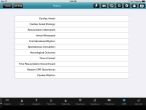Add CPR (cardiopulmonary resuscitation) information
Cardiopulmonary resuscitation (CPR) is an emergency procedure attempting to restore spontaneous circulation and breathing by performing chest compressions, with or without ventilation, in an effort to manually preserve intact brain function until further measures can be taken.
-
(If you have not done so already) Add a new incident, or open an existing incident, as described Add or edit an incident.
By default, the Scene tab appears.
-
At the bottom of the screen, touch Signature.
Fields appear for recording cardiopulmonary resuscitation data.
-
Under CPR, enter data as described in Understand the interface and data entry in it.
Field Information needed Cardiac Arrest
An indication of whether or not cardiac arrest occurred, and if one did occur, whether or not it was before EMS personnel arrived.
Cardiac arrest, also known as cardiopulmonary arrest or circulatory arrest, is the cessation of normal circulation of the blood due to failure of the heart to contract effectively. A cardiac arrest is different from (but may be caused by) a heart attack, where blood flow to the muscle of the heart is impaired.
Cardiac Arrest Etiology
The apparent cause or origin of the cardiac arrest, such as an unexpected arrest, trauma, drowning electrocution, and so forth.
Resuscitation Attempted
The types of resuscitation attempted on the victim, such as ventilation, chest compressions, defibrillation, and so forth. A resuscitation attempt the act of attempting to maintain or restore life by establishing or maintaining airway (or both), breathing, and circulation.
Arrest Witnessed
An indication of whether or not the arrest was seen or heard by another person, and by whom.
First Monitored Rhythm
The first type of cardiac rhythm present when a monitor or defibrillator is attached to a patient after a cardiac arrest.
Spontaneous Circulation
An indication of whether or not the patient began breathing (more than an occasional gasp), coughing, or movement. and if spontaneous circulation did occur, whether or not it was before medical personnel arrived.
Neurological Outcome
A simple validated neurological score such as the Cerebral Performance Category (CPC) should be recorded, if available.
Time of Arrest
An indication of how long it has been since the arrest happened to the time EMS personnel arrived.
Time of Resuscitation Discontinued
The date and time the person performing CPR stopped resuscitation.
Reason CPR Discontinue
An indication of why the person performing CPR stopped.
Cardiac Rhythm
An indication of what kind of rhythm the patient's heart had after CPR had stopped.
